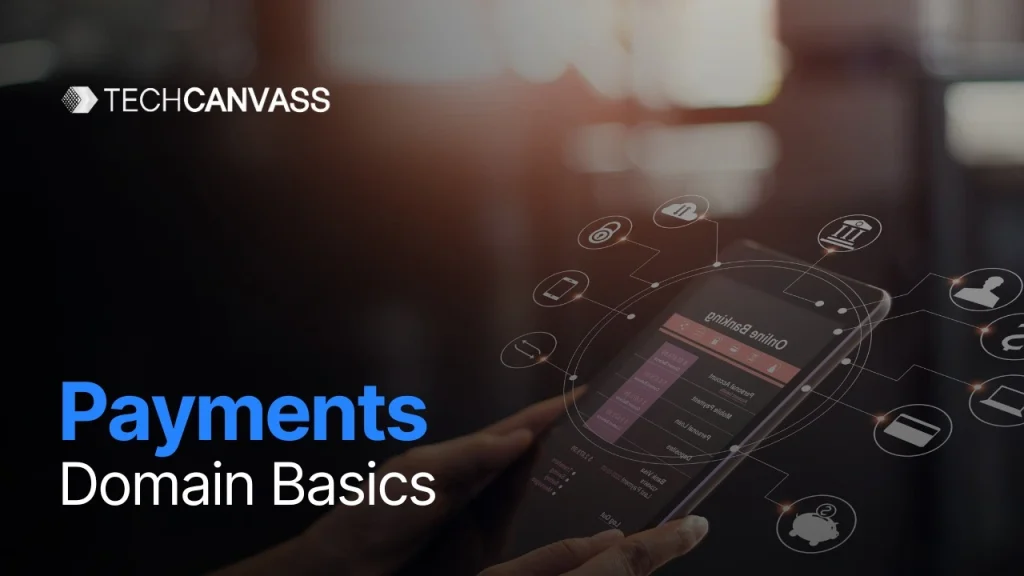Last Updated on September 18, 2025 by Techcanvass Academy
Table of Contents
Overview
Understanding the dynamic environment where financial transactions, technology, and customer experience interact is based on having a solid understanding of the payments domain. In this article, we explore the payments domain’s basic elements and the crucial part it plays in the current financial landscape.
Join us on this journey to get a thorough understanding of the payments domain knowledge whether you’re an enthusiast or a seasoned expert. Discover the essential procedures and significant figures in this industry, and arm yourself with the knowledge required to succeed in the constantly changing world of finance.
Payments Domain System
The payment system’s fundamental function is to operate as the binding agent for the world of financial transactions. Making sure that money flows properly from one place to another is similar to being the conductor of an orchestra.
I. Traditional Payment Systems
Think of the traditional payment methods as the traditional ones. The standard procedures in the past were cash, checks, and even barter systems. Using cash to pay for groceries or a check to pay your debts are two examples.
II. Modern Payment Systems
Modern payment systems have assumed a prominent role in the current digital era. Credit and debit cards, mobile wallets, such as Apple Pay or Google Pay, and online bank transfers are some of them. They make it simple to shop online, pay bills, or split a meal with pals since they are quick and convenient.
Payment systems connect buyers and sellers and facilitate our transactions; they are the hidden heroes of the financial world. Payment systems are the forces powering the economy ahead, whether simply giving over cash or swiping a card, sending a digital payment, or even just sending one.
Useful Link – Payments Domain Certification
How payments are made?
The modern world offers a wide range of payment methods, each with its own special benefits and conveniences, to choose from:
1. Card-Based Payment System:
A. Credit Cards:
Credit cards are tools for managing money that let you make purchases up to a pre-set credit limit on credit. The credit card company provides you with the funds to complete the transaction when you use a credit card. You must pay back the borrowed money, frequently with interest, usually once a month. Credit cards are a popular choice for many consumers since they provide convenience and the option to pay for products over time.
B. Debit Cards:
On the other hand, debit cards are directly connected to your bank account. When you make a purchase using a debit card, the transaction amount is immediately taken out of your available funds in your bank account. Debit cards do not incur interest and do not require borrowing money. They offer a practical method for making rapid payments.
C. Charge Cards:
Similar to credit cards, charge cards also let you make purchases on credit. At the end of each payment cycle, you must pay the entire outstanding sum, unlike with credit cards. Charge cards are an alternative for those who want to avoid accumulating debt because there is no possibility of carrying a balance over time.
D. Virtual Cards:
Digital versions of real credit or debit cards are known as virtual cards. They add an additional layer of security when utilized for online transactions. Virtual cards reduce the danger of unauthorized use by generating a different set of card data for each transaction. When buying online, they are especially helpful for protecting your card details.
E. Prepaid Card
Prepaid cards are those that have money placed onto them in advance. These cards are used up till the balance is exhausted. They are a safe and practical tool to manage spending because they are not connected to a bank account. Prepaid cards are frequently used as gift cards, for online purchases, and for budgeting.
2. Paper-Based Payments System:
A. Demand Drafts
Demand drafts are a type of payment where the payer directs their bank to pay the payee a certain amount. It is a safe approach that is frequently used for expensive transactions like home purchases, tuition payments, or foreign payments. Demand drafts offer a payment assurance because the payer’s bank verifies the availability of the cash.
B. Cheques
Cheques are written requests for a bank to send a certain sum of money to an individual or group. They are a standardized and widely accepted form of payment. Cheques are frequently used for many different financial operations, such as paying bills, paying salaries, and conducting business. They offer a precise payment record.
C. Payment Orders or Banker’s Cheques
Banks instead of individuals issue payment orders, often called banker’s checks. Due to the fact that they are issued and guaranteed by a financial institution, they provide a higher level of assurance. Payment orders are frequently employed in large transactions when a high degree of confidence is necessary.
3. Cash-Based Payment System
Physical coins and banknotes are used in cash-based payments to complete transactions. Because cash is quick and tactile, this traditional method of payment works well for in-person transactions when computerized payment options are either unavailable or not acceptable. It is frequently used for regular expenditures like food, small retail transactions, and other necessities.
4. Electronic-Based Payment System
A. Real-Time Gross Settlement (RTGS)
The RTGS technology is utilized for quick, high-value interbank transfers. It is appropriate for handling huge amounts of money since it allows for real-time settlement of transactions. Large capital transfers, the trading of securities, and the payment of debts are all common uses of RTGS.
B. National Electronic Fund Transfer (NEFT)
In India, the NEFT electronic money transfer system is frequently used for lower-value transactions. It enables electronic money transfers between banks for both private citizens and commercial entities. NEFT transactions are handled in batches and frequently have set business hours.
C. Immediate Payment Service (IMPS)
The real-time interbank electronic payment system in India is called IMPS. It enables users to conduct immediate financial activities, including mobile-to-mobile transfers, and payments between bank accounts. The ease and speed of IMPS make it appropriate for a variety of financial transactions.
5. Mobile-based Payment System
A. Unified Payments Interface (UPI)
A mobile-based payment system in India called Unified Payments Interface (UPI) enables immediate transfers of money across bank accounts.It enables consumers to seamlessly complete transactions by connecting their bank accounts to a mobile app. Peer-to-peer payments, bill payments, and online shopping are just a few of the uses that have seen widespread adoption of UPI.
B. Digital Wallets
Wallets like PayPal, Apple Pay, or Google Pay save the details of your bank and credit cards and enable simple mobile payments..
C. QR Codes
Two-dimensional barcodes called QR codes are used to store data in a matrix pattern made up of white space between black squares. They were first created in Japan to track automobile parts, but they have subsequently expanded to be used for many other things, such as payments and information retrieval.
Understanding NFC Technology in the Payments Domain
Conclusion
In conclusion, the world of payments is always changing, and in today’s fast-paced business environment, understanding its principles is crucial. The financial industry’s beating heart is the Payment Domain, making expertise in it not only a plus but a must.
Are you ready to find out the basics of the payments industry? To prepare you to work on any software projects in the payments domain, a course by Techcanvass on the Payments Domain is made to teach you about payment systems. Once you enroll for the course, you will have access to video lectures, chapter-wise quizzes and mock tests, audiobook, flashcards, mind maps, and so much more.
FAQs on Payment Domain
Q1: What is the importance of Payments Domain Knowledge for a career in IT?
A: Payments domain knowledge is critical for IT professionals, as it is a rapidly growing field that requires understanding payment systems, regulations, and industry-specific terminology.
Q2: What are the key components of the payments ecosystem?
A: The payments ecosystem involves various components, including card networks, payment gateways, acquiring banks, and issuing banks.
Q3: How is Payments Domain Knowledge relevant to Business Analysts?
A: A strong understanding of the payments domain allows business analysts to effectively gather requirements, define processes, and manage projects for fintech and banking clients.
Q4: Can you explain the difference between a clearing and settlement system?
A: Clearing involves the exchange of payment data and calculation of obligations, while settlement is the final transfer of funds between financial institutions.
Q5: What are the different types of payment systems?
A: Payment systems can be broadly categorized as wholesale (e.g., RTGS, CHAPS) and retail (e.g., card payments, mobile payments).
Q6: What is the role of a Payment Gateway in a transaction?
A: A payment gateway authorizes and processes a credit or debit card transaction, ensuring secure data transmission between the merchant and the payment network.
Q7: How can I gain practical Payments Domain Knowledge?
A: You can gain practical knowledge through the Payments Domain Training course provided by Techcanvass, which is designed to help professionals in the IT sector.



